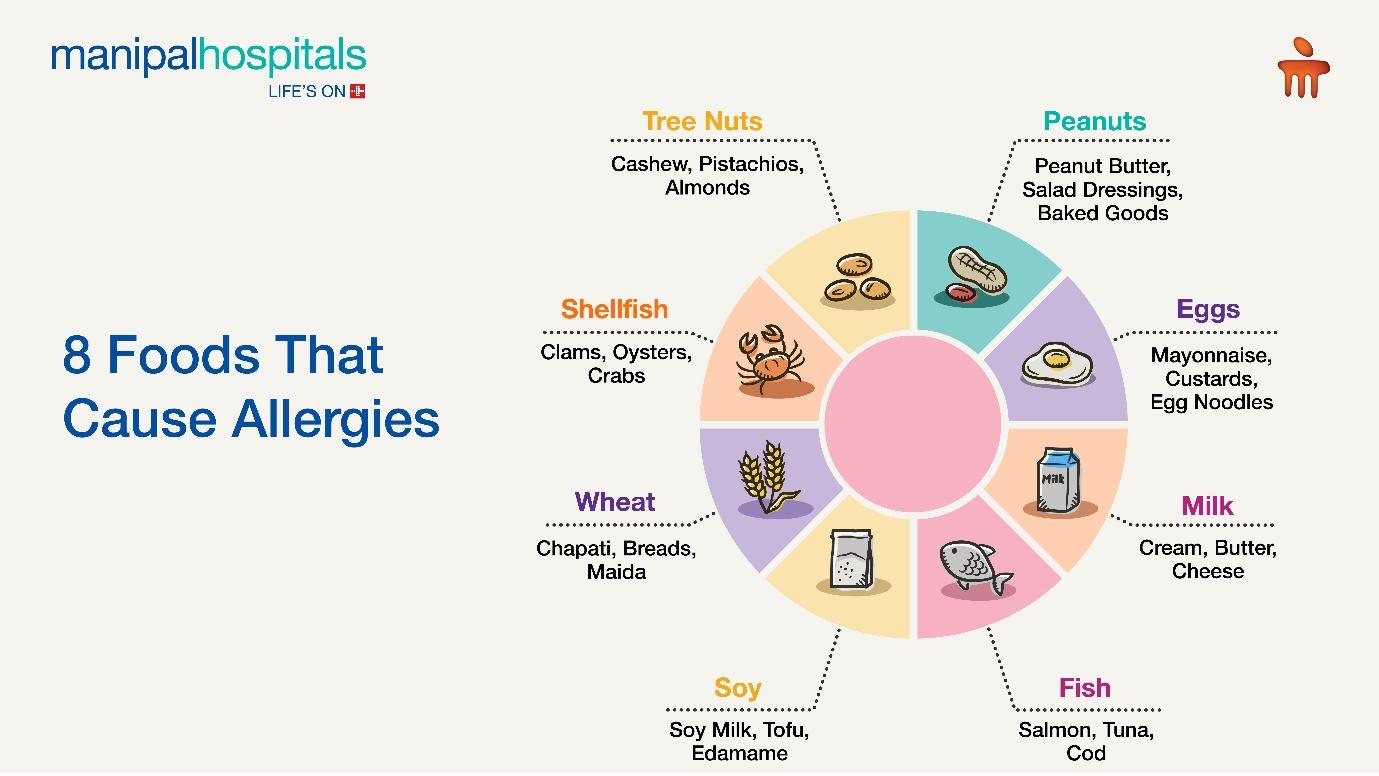
A food allergy is an exaggerated immune response to certain proteins present in food. If the body senses a protein as an allergen and deems it threatening, it creates antibodies to fight it, creating a response to the allergic reaction to food. The allergic response is of two types:
-
IgE Mediated: IgE is a type of antibody (protective Y-shaped immune protein) created in the body. In an IgE response, histamines, an inflammatory molecule, are released to fight off the perceived invader (aka the food allergen). This triggers a typical allergy response.
-
Non-IgE Mediated: This type of immune response involves other parts of the immune system that are not the IgE antibody, resulting in allergy symptoms in the stomach.
Food Allergy Symptoms
Some common symptoms of food allergies include:
- Swelling of tongue, mouth, or feet
- Difficulty in breathing
- Low blood pressure
- Vomiting
- Diarrhoea
- Hives and itchy rashes
- Sore throat
- In severe cases, anaphylaxis
Common Foods That Cause Allergies
Food skin allergies make it difficult for people who have them because they fear consuming the allergen. While food can potentially trigger an allergic reaction, some foods are more commonly associated with allergies than others. Here is a list of 8 common foods that cause allergies:

1. Eggs
The second most common food allergy in children. It is often an egg white allergy as it has higher protein content such as ovomucoid, ovalbumin, and ovotransferrin. While many outgrow this allergy by adulthood, some individuals remain allergic to eggs throughout their lives. Food allergy treatment usually involves an egg-free diet, however cooking and baking may change the shape of the egg white protein making them a lesser threat to the body.
2. Milk
Another common childhood food allergy, this allergy is when there is an adverse immune reaction to proteins (like casein) present in cow’s milk. A milk allergy is not a lactose intolerance, where the latter has a non-functional lactase enzyme. Many children outgrow milk allergies by age 3, but some persist into adulthood.
3. Tree Nuts
Tree nuts include almonds, cashews, walnuts, macadamia, pistachios, pine nuts, and pecans. As one of the frequent allergy causes, tree nut allergies stay throughout life and can cause anaphylaxis. Avoiding foods that contain these nuts and carrying an epinephrine auto-injector is crucial for individuals with these allergies.
4. Peanuts
Essentially a legume, peanuts contain many proteins which trigger severe allergies. As a common food allergy, peanuts trigger reactions that range from mild symptoms like rashes and stomach discomfort to life-threatening anaphylaxis. Treatment involves the same strategies as those for tree nut allergies.
5. Shellfish
In shellfish allergies, the body attacks proteins in molluscs like clams and oysters and crustaceans like shrimp, prawn, crab, and lobster. The reactions are to proteins like tropomyosin, arginine kinase, and parvalbumin. Symptoms range from mild to severe, and the allergy tends to be lifelong. The treatment involves avoiding all kinds of shellfish.
6. Wheat
A wheat allergy is when there is an intense reaction to proteins found in wheat alone (unlike celiac disease where allergy is particularly towards gluten also present in other grains like barley and rye) Symptoms can range from digestive issues to respiratory problems and, in severe cases, anaphylaxis. Avoiding wheat and wheat-containing products is essential for managing this allergy.
7. Soy
Soy is a widely consumed legume and a common ingredient in many processed foods. Soy allergies, while less common than other food allergies, can cause a range of symptoms. Strict avoidance of soy-containing products is necessary for individuals with soy allergies.
8. Fish
Fish allergies are relatively common and can be triggered by various species of finned fish. Fish allergies differ from shellfish allergies as the proteins are not the same. The allergic reaction is mostly to the protein parvalbumin. Reactions can vary in severity and may involve skin, respiratory, and gastrointestinal symptoms. Individuals with fish allergies must strictly avoid consuming any type of fish or products that may contain fish derivatives.
Managing Food Allergies
Food allergies can significantly affect an individual's quality of life and require diligent management. Here are some key steps to take:
-
Identification: Find out which food allergy you have and consult a specialist to undergo appropriate food allergy testing for food allergy treatment.
-
Avoidance: Strictly avoid consuming the allergen and carefully read food labels for hidden sources.
-
Emergency Preparedness: Carry emergency medications like epinephrine auto-injectors, and antihistamines in case of accidental exposure.
-
Education: Inform your family, friends, and caregivers about your food allergies so that they can also be on the lookout for you.
It is important to remember that food allergies can be unpredictable and severe reactions can occur even with diligent avoidance measures. If you suspect a food allergy or food allergy testing consult our experts from the Internal Medicine department at Manipal Hospitals, Vijayawada. Our qualified healthcare professionals will help identify the kind of food allergy you have and offer you guidance.
FAQ's
A food allergy involves an immune system response, while intolerance typically relates to digestive issues without immune system involvement.
Currently, there's no cure for food allergies. Management involves strict avoidance of the allergen.
Anaphylaxis is a severe, potentially life-threatening allergic reaction. It's treated with epinephrine, usually via an auto-injector.
Follow your emergency action plan. If symptoms are severe, use your epinephrine auto-injector and seek immediate medical attention.



















 4 Min Read
4 Min Read

.png)











